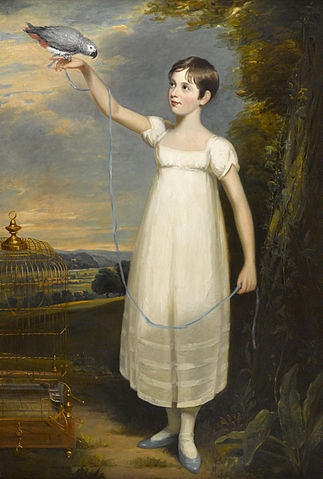Here’s another post in our ongoing series on Regency fabrics.
As I have in previous posts, I’ll be examining actual fabric samples glued into several earlier editions of Ackermann’s
Repository, samples supplied by the manufacturers and published by Ackermann in order to boost the British cloth-making industry at a time when exporting British goods to Europe was almost impossible because of the Napoleonic war. I'll give you a close-up scan of each sample, the published description if available, and my own observations of the color, weight, condition, and similarity to present-day materials, to give you as close a picture as possible of what these fabrics are like. So here we go!
Today’s four samples are from the January 1812 issue of Ackermann’s
Repository. The overall condition of my copy is very; the page itself is free of foxing and is only slightly toned; two of the samples (in white) have suffered some foxing.
No. 1. is an article of peculiar neatness and of great durability, particularly appropriated for ladies’ morning dresses, and children’s frocks and trowsers, the figure never being removed by washing. We are favored with this delicate article from the house of Millard, in Cheapside, where it may be obtained; and where it forms a part of the many elegant articles peculiar to that celebrated establishment, which certainly is unrivalled, both in the variety, richness, and elegance of its supplies; and possesses, at the same time, the advantages of a superior economy. We believe our fair fashionables are well acquainted with this Repository
of foreign and British manufactures; but for the information of our correspondents who reside in the country or in distant climes, we must observe, that this house furnishes the greatest choice of fashionable articles for ladies’ wear and household use, as well as rich furniture for drawing-rooms, bed-rooms, &c. These may be purchased from the singularly low price of one shilling per yard, and upwards. The most costly and best productions of India are to be found here. Their Indian shawls, we understand, are offered from eight, to one hundred and fifty guineas each. Their linens of Russia, Irish, German, and Valenciennes manufacture, are of the first fabric. Their printed silks, bettillas, and muslins are of a unique description. Their white chintz, anjengos, and long cloths for children’s wear, are of singular durability and beauty. This house is of the first respectability, each article is warranted, and all goods purchased by the piece, or demi, are obtained at the wholesale price, as well as those purchased by the entire case of package.
My comments: Wow, that was quite a puff-piece, Mr. Ackermann! As the for fabric sample itself, it’s an attractive corded weave, with a pattern woven into the cording. It’s a little hard to judge how long-wearing this might be for children’s clothes, as the ground fabric is of very fine thread, like a muslin, though the threads are evenly spun. But it’s certainly pretty. A couple of definitions, by the way:
bettilla is a muslin woven in southern India, and
anjego appears to be a similar product of India; I found references to anjengo and anjengo longcloth.
Oh—and 150 guineas for one shawl?!
No. 2. is a delicate and animated printed cambric, for morning or domestic wear. The style of this article must be necessarily simple and plain, as will be obvious to the purchasers. It is sold by Messrs. Smith and Co. Tavistock-street, Covent-Garden.
My comments: More quilting fabric. ☺ The cambric is tightly and evenly woven, and the printing clear and well done...and, um, yeah, definitely no trimming needed on a dress made from this!
No. 3. A white cotton velvet of a peculiarly delicate fabric, designed for the fashionable amusement of painting, an art now particularly in vogue with our fair fashionables, who have wisely relinquished the inelegant and unprofitable employ of shoe-making and book-binding in favour of their industrious, half-ruined, and more humble brethren*. This article, as well as the colours for painting, are sold at Ackermann’s Repository, No.101, Strand; and it is a peculiar advantage to the public, that they may obtain at this house drawings and patterns for copying on the following terms:
Yearly subscriptions, 4 guineas.
Half-year do............ 2 do.
Quarterly do............1 do.
The money to be paid at the time of subscribing, &c. &c. Printed particulars may be had at the Repository of Arts, 101, Strand.
*See the speech of PETER CORDOVAN, vol.4, page 16, Repository of Arts, &c.
My comments: Oh my word, more painting on velvet. I think I feel a blog post coming on...and a little research into the footnote as well! As for the sample of velvet itself, it’s very like what we would call cotton velveteen, with a short, plush nap.
No. 4. A fine Merino cloth, of Wellington bronze
, a colour in the highest esteem in fashionable circles. It may be termed the orange colour sobered
. It is adapted for robes, pelisses, and mantles, and should be trimmed with a tastefully contrasted fur, variegated chenille, or swansdown. We have seen the Carmelite mantle composed of this material, lined with white sarsnet, with white raised chenille borders, and confined at the throat with rich correspondent cord and tassels, to have a very tasteful effect. This cloth is furnished by Mess. Ghrimes, of Ludgate-hill, whose house is famed for producing the most brilliant in-grain colours in cloth
ever exhibited. The present article measures two yards wide, and the price 36s. per yard.
My comments: Ooh, nice fabric! The color is a dark pumpkin—a brownish orange—but it’s the fine twill weave that makes this noteworthy—pliable and nicely drape-able, but sturdy. It would make a cozy winter gown, if a slightly scratchy one (so definitely a lining would be needed in the bodice.)
Any comments on this month's fabrics?


























